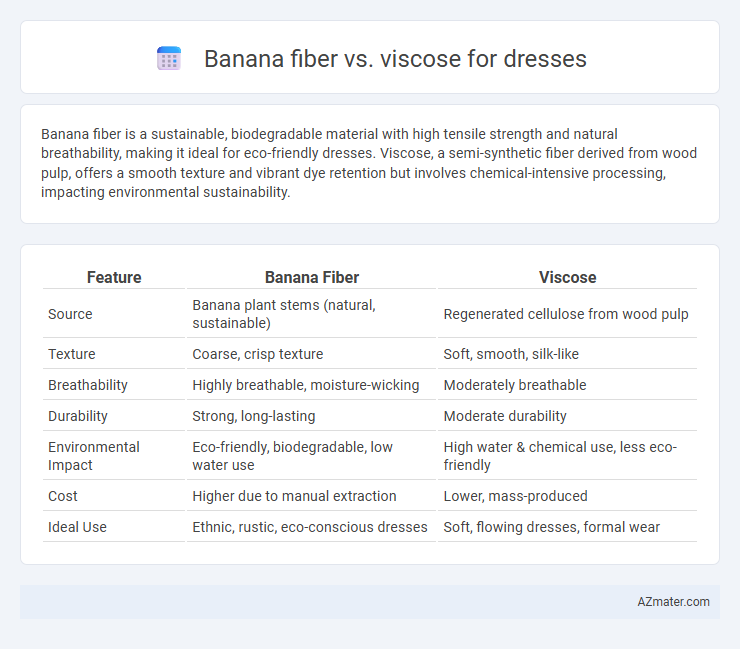Banana fiber is a sustainable, biodegradable material with high tensile strength and natural breathability, making it ideal for eco-friendly dresses. Viscose, a semi-synthetic fiber derived from wood pulp, offers a smooth texture and vibrant dye retention but involves chemical-intensive processing, impacting environmental sustainability.
Table of Comparison
| Feature | Banana Fiber | Viscose |
|---|---|---|
| Source | Banana plant stems (natural, sustainable) | Regenerated cellulose from wood pulp |
| Texture | Coarse, crisp texture | Soft, smooth, silk-like |
| Breathability | Highly breathable, moisture-wicking | Moderately breathable |
| Durability | Strong, long-lasting | Moderate durability |
| Environmental Impact | Eco-friendly, biodegradable, low water use | High water & chemical use, less eco-friendly |
| Cost | Higher due to manual extraction | Lower, mass-produced |
| Ideal Use | Ethnic, rustic, eco-conscious dresses | Soft, flowing dresses, formal wear |
Introduction to Banana Fiber and Viscose
Banana fiber, derived from the pseudostem of banana plants, is a natural, eco-friendly textile known for its strength, durability, and biodegradability. Viscose, a semi-synthetic fiber made from cellulose extracted from wood pulp, offers a soft, silky texture but often involves chemical-intensive processing. Both fibers are popular in sustainable fashion, with banana fiber emphasizing organic origins and viscose balancing natural cellulose with industrial manufacturing.
Origins and Sources of Each Fiber
Banana fiber is derived from the pseudostems of banana plants, primarily cultivated in tropical regions such as India, the Philippines, and Nepal, making it a sustainable byproduct of banana agriculture. Viscose, a type of rayon, is produced from cellulose extracted mainly from wood pulp sourced from fast-growing trees like eucalyptus, beech, and pine, with large-scale production centers in countries like China and Indonesia. The natural origins and agricultural waste basis of banana fiber contrast with the chemically processed cellulose input of viscose, influencing their ecological footprints and textile properties.
Production Processes Compared
Banana fiber production involves extracting fibers from banana plant stalks through retting, followed by drying and spinning, emphasizing eco-friendliness and minimal chemical use. Viscose production requires chemically treating cellulose from wood pulp or bamboo with sodium hydroxide and carbon disulfide, resulting in intensive energy consumption and hazardous waste byproducts. The sustainable extraction and biodegradable nature of banana fiber contrast sharply with viscose's chemical-intensive processes and environmental impact.
Environmental Impact Assessment
Banana fiber, derived from the pseudostem of banana plants, is a sustainable and biodegradable textile material that reduces agricultural waste and requires minimal water and pesticides compared to viscose production. Viscose, made from cellulose often sourced from wood pulp, involves chemically intensive processes that contribute to deforestation, water pollution, and high carbon emissions. Environmental impact assessments consistently highlight banana fiber's lower ecological footprint, promoting it as a greener alternative for dress fabrics.
Durability and Strength Differences
Banana fiber offers superior durability and tensile strength compared to viscose, making it ideal for long-lasting dress fabrics. Its natural cellulose structure provides robust resistance to wear and tear, while viscose, being a regenerated cellulose fiber, tends to be softer but less resilient under stress. The enhanced strength of banana fiber ensures dresses maintain shape and integrity through multiple wears and washes, outperforming viscose in longevity.
Comfort and Breathability: Which is Better?
Banana fiber offers superior breathability compared to viscose, making it ideal for warm climates due to its natural moisture-wicking properties and lightweight texture. Viscose, while smooth and soft, tends to retain moisture and can feel heavier, leading to less comfort during prolonged wear in hot or humid conditions. For optimal comfort and ventilation in dress fabrics, banana fiber outperforms viscose by enhancing airflow and reducing sweat buildup.
Aesthetic Appeal and Fabric Texture
Banana fiber offers a unique, natural texture with a slightly coarse yet smooth finish that adds an organic and rustic aesthetic appeal to dresses, highlighting eco-friendly fashion. Viscose, known for its silky, soft, and lightweight feel, provides a luxurious drape and vibrant color retention, perfect for creating elegant and flowy garments. The choice between banana fiber and viscose fabric directly influences the tactile experience and visual charm of the dress, balancing sustainability with sophistication.
Cost and Market Availability
Banana fiber is increasingly recognized for its eco-friendly properties and unique texture, but it tends to be more expensive and less widely available in the fashion market compared to viscose. Viscose, derived from wood pulp, remains a cost-effective and highly accessible fabric, dominating dress production due to its affordability and established supply chains. Market availability of banana fiber is limited to niche, sustainable brands, whereas viscose enjoys large-scale manufacturing and global distribution, influencing cost and accessibility for designers and consumers alike.
Sustainability and Eco-Friendly Factors
Banana fiber, derived from banana plant stalks, offers a highly sustainable and biodegradable alternative to viscose, which relies on chemically intensive processes involving wood pulp and toxic solvents. The production of banana fiber consumes less water and energy, reducing its environmental footprint compared to viscose, which is often linked to deforestation and pollution. Choosing banana fiber for dresses supports circular fashion by utilizing agricultural waste, promoting eco-friendly textile manufacturing and reducing landfill waste.
Summary: Which Fiber is Best for Dresses?
Banana fiber offers exceptional breathability, biodegradability, and a natural texture, making it ideal for sustainable and eco-friendly dresses. Viscose provides a smooth, silky feel and excellent drape, but involves chemical processing that can impact the environment. For eco-conscious consumers seeking durability and natural aesthetics, banana fiber is the preferable choice, while viscose suits those prioritizing softness and elegant flow in dress fabrics.

Infographic: Banana fiber vs Viscose for Dress
 azmater.com
azmater.com